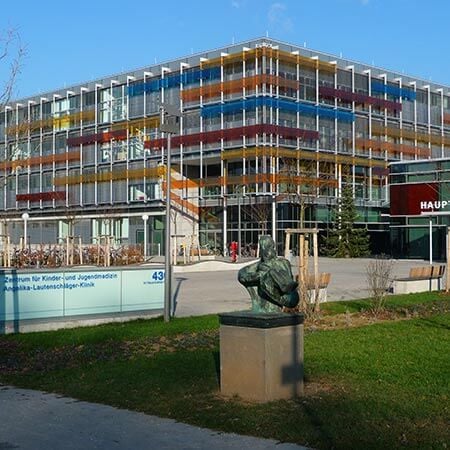Pulmonary valve insufficiency is a rare heart disease. It can be congenital or acquired. Most acquired forms of severe pulmonary regurgitation develop due to the medical interventions for other heart defects. The standard treatment for severe pulmonary regurgitation is valve replacement. The most common types of prostheses used are biological ones. Hospitals abroad perform not only open, but also minimally invasive transcatheter heart interventions.
Content
- Causes of pulmonary regurgitation
- Is pulmonary regurgitation dangerous
- Pulmonary valve repair
- Pulmonary valve replacement
- Minimally invasive pulmonary valve replacement
- Primary minimally invasive valve replacement
- Does the treatment cause any complications
- The near future of minimally invasive valve replacement
- Minimally invasive revision valve replacement
- Why is it worth undergoing treatment abroad
- Treatment in Europe at an affordable price
Causes of pulmonary regurgitation
The most common cause is pulmonary hypertension. However, heart disease usually does not progress to a severe degree in patients suffering from this pathology. Therefore, doctors provide the treatment of the underlying disease, but do not resort to heart valve replacement.
Below are the main causes of severe pulmonary regurgitation, which require surgical treatment:
- Surgical repair of tetralogy of Fallot (the need for pulmonary valve replacement occurs in every fourth child after heart surgery).
- Balloon valvuloplasty involves the dilatation of a narrowed pulmonary valve (in its stenosis) using a balloon.
Rare causes of pulmonary regurgitation are as follows:
- Heart tumors.
- Infective endocarditis.
- Idiopathic (of unknown origin) pulmonary trunk enlargement.
- Rheumatic heart disease (autoimmune inflammation of the heart caused by streptococcal infection).
In pulmonary regurgitation, blood returns from the pulmonary artery back to the heart. This leads to its volume overload. As a result, the heart chamber expands, which disrupts the heart function. The defect progresses faster in patients with tetralogy of Fallot, since their right ventricle is initially hypertrophied (thickened).
Is pulmonary regurgitation dangerous
Pulmonary regurgitation is dangerous if it is severe. Over time, it causes pathological changes in the heart. The condition causes the enlargement of the right ventricle and heart failure develops.
The pathology is well tolerated by patients for a long time. Symptoms are not felt even in severe pulmonary regurgitation, including in cases where the valve is virtually absent. However, after a few years or decades, physical exercise tolerance worsens. If left untreated, the following signs of right ventricular heart failure appear:
- Shortness of breath.
- Liver pulsation and pain in the right hypochondrium.
- Pulsation and enlargement of the veins in the neck.
- Leg swelling.
Moderate or minimal pulmonary regurgitation is usually not dangerous. It can be detected during echocardiography, but the condition usually does not cause any symptoms and does not require surgical treatment.
Pulmonary valve repair
Pulmonary valve repair is a relatively rare heart surgery. However, in some cases, it is possible to eliminate regurgitation without valve replacement surgery, while retaining the patient's own valve.
Such surgical interventions on the heart are performed in case of damage to the leaflets, for example, due to endocarditis. In this case, the doctor performs their plastic surgery with an auto-pericardium. The pericardium is a sac of connective tissue, which surrounds the heart. It is used to close defects or form new valves.
Such forms of pathology are quite rare. As a rule, if the pulmonary valve is damaged, then the tricuspid valve also needs to be repaired. It is also located in the right side of the heart, between the atrium and the ventricle. Doctors can repair both valves within a single surgery, if required.
Pulmonary valve replacement
Severe pulmonary regurgitation most often develops in patients after surgical repair of congenital heart defects. There are two main causes: surgical repair of tetralogy of Fallot and balloon angioplasty for congenital pulmonary stenosis. When performing balloon angioplasty, valve opening, which was initially too narrow, is enlarged. However, in some patients, its enlargement is excessive, so pulmonary regurgitation develops instead of pulmonary stenosis.
A standard pulmonary valve replacement surgery is performed through a large incision in the thorax. At the same time, the doctor may repair or replace the tricuspid valve. In the prolonged course of pulmonary insufficiency, right ventricular enlargement is possible. In this case, a relative insufficiency of the valve located between the atrium and the ventricle develops, since the opening, which it should close, becomes too wide.
Doctors usually do not implant mechanical artificial valves in the pulmonary artery. Cardiac surgeons implant biological prostheses. Although they are less durable, such valves are less likely to cause thrombosis and patients do not need to take anticoagulants continuously.
In the pulmonary position, the survival rate of bioprostheses is quite high. They can serve for 15-30 years or more in adult patients. They serve much less in children. The service life depends on the child's age at the time of the bioprosthesis implantation: the younger the patient, the earlier the valve will have to be replaced. The problem is not only its degradation, but also an increase in the diameter of the vessels. The child's arteries grow, but the valve remains the same, so it quickly becomes irrelevant.
In a mixed group of patients (adults and children), the survival rate of bioprostheses is the following:
- Five-year survival – 81%.
- Ten-year survival – 58%.
- Fifteen-year survival – 41%.
Significantly better long-term results are achieved in adult patients. Fifteen-year survival rate of biological valves reaches 75% in them.
Minimally invasive pulmonary valve replacement
Most patients want to avoid open-heart surgery. It is traumatic, sometimes causes complications, and requires long-term rehabilitation. Developed countries use several options of minimally invasive valve replacement interventions for the treatment of pulmonary valve insufficiency.
Primary minimally invasive valve replacement
After plastic repair of the right ventricular outflow tract for tetralogy of Fallot, patients need pulmonary valve replacement. In 25% of cases, it can be performed using minimally invasive techniques. The key condition for this intervention is the minimal diameter of the valve annulus.
Doctors most often implant a Melody valve (Medtronic). It has already been implanted in more than 15 thousand patients, mainly in countries with advanced medicine. The bioprosthesis is delivered to the vessels through an incision in the groin. The doctor inserts the catheter through the femoral vein. A bioprosthesis for transcatheter implantation is a stent valve. It is made from the bovine jugular vein, and is located inside a metal stent (frame).
The valve remains the most researched for minimally invasive implantation. It is available in different sizes, allowing the doctors to choose the most suitable prosthesis for each patient. The success of the implantation is achieved in an average of 90% of cases. If the stent valve is implanted by experienced specialists, then the efficiency of the procedure exceeds 95%.
After implanting a bioprosthesis, good hemodynamic results persist for at least 5 years. It is possible that in some patients an artificial valve can serve for decades: a long monitoring period is needed to clarify it, because stent valves for transcatheter implantation have been used in clinical practice relatively recently.
The second most popular bioprosthesis among cardiac surgeons is SAPIEN XT. It is a tricuspid valve from the bovine pericardium. It is enclosed in a cobalt frame. Initially, it was developed for transcatheter aortic valve replacement, but today it is successfully implanted in the pulmonary artery.
This bioprosthesis began to be used later, and there are not many studies on it. However, there are already results of applications for three years. Apparently, it is in no way inferior to the Melody valve in terms of short-term and long-term results. The success of the implantation procedure is achieved in 95% of cases. The need for revision surgery occurs in 2,9% of patients within 12 months and in 6,3% of patients within 3 years of follow-up monitoring.
Thus, transcatheter stent valves have the following benefits:
- They serve long, possibly as long as conventional valves implanted during open-heart surgery.
- They are implanted using minimally invasive techniques, without incisions on the thorax, without long-term rehabilitation, and with the shortest possible period of hospital stay.
- The surgical intervention is successful in more than 95% of cases if it is performed in the cardiac surgery center, where such interventions are carried out regularly.
Nonetheless, not all patients are considered candidates for this treatment option for pulmonary valve insufficiency. You can go abroad and undergo a diagnostic examination to find out if transcatheter valve replacement can become an option of choice in your case.
Does the treatment cause any complications
The complications can occur after transcatheter pulmonary valve replacement, although they are less common than after open interventions and are usually not severe.
Here are some possible complications that can develop after the implantation of any transcatheter bioprosthesis:
- Conduit rupture in patients after surgery for tetralogy of Fallot (severe ruptures occur with a frequency of no more than 1%).
- Coronary artery compression develops on average in 5% of patients, but in centers with vast experience this complication is almost never encountered, since doctors perform coronary angiography during the conduit balloon plastic surgery (dilatation) when performing valve implantation.
- Endocarditis, which is an inflammation of the inner lining of the heart, develops with a probability of 2,4% (the risk is not higher than after open-heart valve replacement).
In addition, Melody valves sometimes break. Mechanical failure of the framework was quite common, as soon as this bioprosthesis was used. Today, doctors do prestenting, which reduces the load on the valve and reduces the risk of failure to 3%.
The near future of minimally invasive valve replacement
New artificial valves for transcatheter placement are being currently tested and will probably be approved for clinical use in the near future. They will improve the long-term results of the procedure and make minimally invasive valve replacement possible for those who previously had to undergo open-heart surgery.
Standard transcatheter bioprostheses cannot be implanted in patients with a large diameter of the valve annulus. The Melody valve is available in a maximum size of 2,2 cm, and the SAPIEN valve is 2,9 cm. With a larger diameter of the right ventricular outflow tract, open interventions have to be used.
However, the Medtronic Harmony valves and the Alterra Prestent device from the SAPIEN valve manufacturer are currently being tested. The first one has an inlet diameter of 3,4 cm and an outlet diameter of 4,2 cm. The company also tests the TPV 25 valve, which is even larger. Alterra Prestent is a 4 cm hourglass frame for implanting a 2,9 cm SAPIEN stent valve inside it.
So far, these bioprostheses can be implanted only within the clinical trials. Some of them, which will show good results, will be approved for clinical use in developed countries in the near future. They will allow expanding the indications for transcatheter valve replacement.
Another breakthrough in cardiac surgery is the Xeltis device for pulmonary valve repair. The final phase of the trial started in 2021. The valve has previously been implanted in children, and four-year follow-up monitoring has shown good results. The essence of the method is in the implantation of an artificial valve, which consists of a microporous biodegradable material. Over time, the patient's own cells penetrate into the pores, and the implanted prosthesis dissolves. As a result, the heart's own valve grows inside the vessel, which can grow with the child.
Minimally invasive revision valve replacement
With all the advantages and potential of transcatheter interventions, most patients still undergo open surgery to implant the prosthesis. Bioprostheses are mostly implanted. They wear out faster and are especially short-lived in children.
Considering that the majority of patients with pulmonary valve insufficiency are young people or children with a high life expectancy, it is obvious that they will need several surgeries during their lifetime to replace prostheses. As far as possible, there should be as few open-heart surgeries as possible, because each subsequent operation is more complex and more dangerous than the previous one.
Developed countries use the transcatheter method for revision valve replacement. The new bioprosthesis is placed on the top of the old one. As a result, the problem of dysfunction of the prosthesis is solved with the use of minimally invasive techniques. Hemodynamics are restored without the need for open-heart surgery.
Why is it worth undergoing treatment abroad
To eliminate the pulmonary valve defects, you can go abroad. Doctors in developed countries use modern, safe, and minimally traumatic interventions. Along with open surgeries, transcatheter procedures are also performed, after which the patients do not have to recover for a long time.
There are several reasons for you to undergo treatment of pulmonary valve insufficiency in one of the countries offering advanced medicine:
- Safe open-heart surgery, which rarely causes complications.
- Whenever required, doctors can simultaneously repair or replace several valves, for example, pulmonary and tricuspid ones.
- The patients with a small diameter of the annulus fibrosus can undergo transcatheter valve replacement surgery.
- Revision prosthetic repair (valve replacement) can be performed using minimally invasive techniques: through the vessels in the leg instead of a large incision on the thorax.
- Transcatheter valve replacement is successful in more than 95% of patients.
- The use of the very latest types of prostheses, which can serve for more than 30 years in adult patients.
- Possibility of the simultaneous treatment of valvular defects and concomitant cardiovascular diseases.
Foreign countries offer the most advanced medical technologies. Clinical trials allow the doctors to implant the very latest types of pulmonary valve prostheses, including large diameter bioprostheses and repairing prostheses, which stimulate the restoration of the patient's own valve.
Treatment in Europe at an affordable price
To undergo treatment in one of the European hospitals, you can use the services of the specialists working at the Booking Health company. On our website, you can see the cost of treatment in Europe, compare prices and book a medical care program at a favorable price. Treatment in Europe will be easier and faster for you, and the cost of treatment will be significantly lower.
You are welcome to leave your request on the Booking Health website to find out the information you are interested in. Our consultant will contact you within 24 hours. The medical tourism facilitator from the Booking Health company will organize your trip for treatment in Europe. We will provide the following benefits for you:
- We will choose a hospital for treatment in Europe, whose doctors specialize in the treatment of pulmonary valve insufficiency and achieve the best results.
- We will help you overcome the language barrier and establish communication with your attending physician.
- We will reduce the waiting time for the medical care program. You will receive medical services on the most suitable dates.
- We will reduce the price. The cost of treatment in a European hospital will be lower due to the lack of overpricing and additional coefficients for foreign patients.
- We will solve all organizational issues, such as paperwork, booking a hotel room, transfer from the airport to the hospital. An interpreter will accompany you abroad.
- We will prepare a program and translate medical documents. You do not have to repeat the previously performed diagnostic procedures.
- We will keep in touch with the hospital after the completion of treatment in Europe.
- We will organize additional medical examinations and treatment in European hospitals, if necessary.
- We will buy medicines abroad and forward them to your native country.
Your health will be in the safe hands of the world's leading doctors. The Booking Health specialists will help you reduce the cost of treatment, organize your trip, and you will only have to focus on restoring your health.
Authors: Dr. Vadim Zhiliuk, Dr. Sergey Pashchenko




















